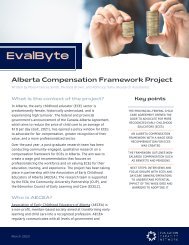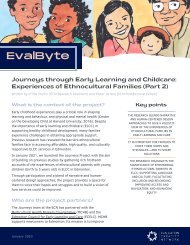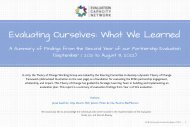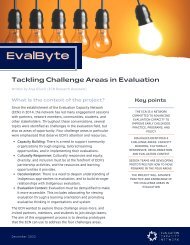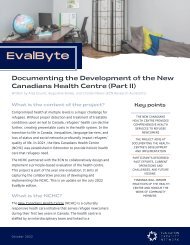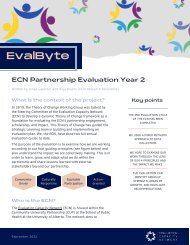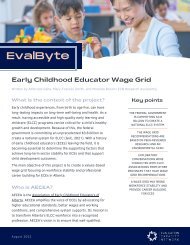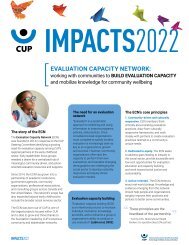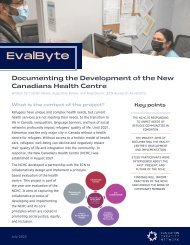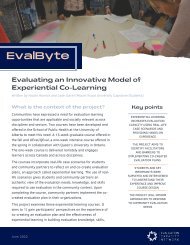Pursuing a Historic Urban Landscape Approach to Heritage in Edmonton
You also want an ePaper? Increase the reach of your titles
YUMPU automatically turns print PDFs into web optimized ePapers that Google loves.
KEY IDEAS FOR DEVELOPING A HUL APPROACH<br />
In summary, <strong>to</strong> capture what is <strong>in</strong>volved <strong>in</strong> the transition <strong>to</strong>wards a HUL approach, we propose the follow<strong>in</strong>g<br />
model contrast<strong>in</strong>g traditional heritage conservation with a more <strong>in</strong>tegrated and complex perspective. This is<br />
<strong>in</strong>tended as a heuristic exercise, and our <strong>in</strong>tent is not <strong>to</strong> polarize the two approaches, or <strong>to</strong> dismiss conservation<br />
and its contribution <strong>to</strong> heritage plann<strong>in</strong>g. Rather, our model sets out some key ideas for creatively explor<strong>in</strong>g<br />
and <strong>in</strong>spir<strong>in</strong>g a dynamic conversation around HUL <strong>in</strong> Edmon<strong>to</strong>n.<br />
A <strong>Landscape</strong> Level <strong>Approach</strong><br />
Where traditional approaches have focused on narrow range of built form, HUL opens the idea of heritage <strong>to</strong><br />
<strong>in</strong>clude not only physical structures, but a much wider range of urban attributes. This could <strong>in</strong>clude elements of<br />
the natural environment, the economy, or a cultural activity. Good practice implies <strong>in</strong>tegrat<strong>in</strong>g and balanc<strong>in</strong>g<br />
heritage attributes, and their values, <strong>in</strong> ways which support open and balanced forms of urban change.<br />
Intersections of the Tangible and Intangible Aspects of Cities<br />
Contemporary perspectives of heritage are often <strong>to</strong>day more aware of heritage as a social construct are far<br />
more <strong>in</strong>clusive than ever before (Sykes & Ludwig, 2015). This <strong>in</strong>cludes the recognition of the values of<br />
<strong>in</strong>tangible heritage <strong>to</strong> positive forms of heritage conservation and urban development. Intangibles are those<br />
traditions and liv<strong>in</strong>g expressions of the past which have been passed <strong>in</strong><strong>to</strong> the present (Jigyasu, 2015) and shape<br />
our values of heritage <strong>in</strong> the present (Bandar<strong>in</strong> and van Oers, 2012: 49). These are the processes by which<br />
his<strong>to</strong>rical mean<strong>in</strong>gs are given <strong>to</strong> places, the s<strong>to</strong>ries we tell about them, and the ways <strong>in</strong> which we live and<br />
experience the city. Yet, <strong>in</strong>tangibles have mostly been less sought after and poorly <strong>in</strong>tegrated with<strong>in</strong> urban<br />
heritage plann<strong>in</strong>g. They are difficult <strong>to</strong> collect, manage and preserve, as well as be<strong>in</strong>g multiple and uncerta<strong>in</strong>.<br />
The <strong>in</strong>ability <strong>to</strong> <strong>to</strong>uch, or physically recreate heritage narratives has made their value seem less than that of the<br />
built or material heritage. This is a particularly challeng<strong>in</strong>g proposition when, as Charles Landry (2006)<br />
describes, we have lost our ability <strong>to</strong> recognise or speak about them. By <strong>in</strong>tegrat<strong>in</strong>g <strong>in</strong>tangible and tangible<br />
heritage values, there is an ability <strong>to</strong> determ<strong>in</strong>e what is required <strong>to</strong> collect the s<strong>to</strong>ries themselves or <strong>to</strong> support<br />
those people who collect and ma<strong>in</strong>ta<strong>in</strong> the s<strong>to</strong>ries and memories that are attached <strong>to</strong> the built heritage. Pay<strong>in</strong>g<br />
attention <strong>to</strong> <strong>in</strong>tangibles as Jigyasu (2015: 130-135) argues is essential <strong>to</strong> attend<strong>in</strong>g <strong>to</strong> the diversity of cultural<br />
heritage <strong>in</strong> cities, and necessary for foster<strong>in</strong>g <strong>in</strong>clusiveness and mutual respect between communities.<br />
Community-Based and Engaged<br />
Where traditional heritage plann<strong>in</strong>g has prefaced the role of experts and local elites (Sykes & Ludwig, 2015) <strong>in</strong><br />
the designation and protection of urban heritage, HUL highlights the importance of engagement. <strong>Heritage</strong><br />
projects should evolve with<strong>in</strong> the community, as opposed <strong>to</strong> be<strong>in</strong>g developed for the community. Publics can<br />
be <strong>in</strong>tegral and knowledgeable partners, able <strong>to</strong> shape and place narratives as well as <strong>in</strong>form heritage sensitive<br />
development. HUL prompts the <strong>in</strong>novation of more active forms of engagement (see for example Healey,<br />
1997). HUL suggests a need <strong>to</strong> create space for communities <strong>to</strong> actively contribute <strong>to</strong> the future of the city and<br />
through this process build positive relationships between communities and between past, present and future.<br />
Most communities are the culm<strong>in</strong>ation of layered identities that evolved over time. Empower<strong>in</strong>g community<br />
8




